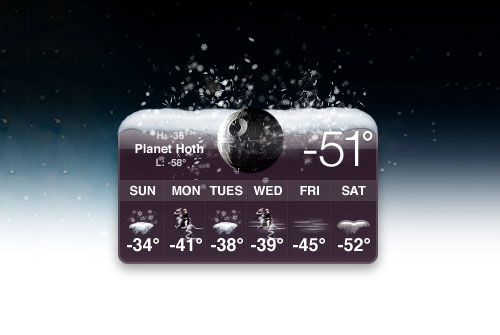Blizzard timelapse
A 20-hour span of blizzard in about 40 seconds. There are several points at which it seems the snow should stop accumulating on the table, but it never does.



This site is made possible by member support. 💞
Big thanks to Arcustech for hosting the site and offering amazing tech support.
When you buy through links on kottke.org, I may earn an affiliate commission. Thanks for supporting the site!
kottke.org. home of fine hypertext products since 1998.
A 20-hour span of blizzard in about 40 seconds. There are several points at which it seems the snow should stop accumulating on the table, but it never does.
What’s the weather like on Dagobah, Alderaan, or Hoth? Find out with these handy OS X Dashboard widgets.

Using journals kept aboard ships and the sweat of volunteers (that’s *you*), Old Weather is attempting to compile a more accurate look at our planet’s recent climate.
Help scientists recover worldwide weather observations made by Royal Navy ships around the time of World War I. These transcriptions will contribute to climate model projections and improve a database of weather extremes. Historians will use your work to track past ship movements and the stories of the people on board.
This summer’s dry English weather has been unexpectantly good for archaeology. Aerial surveys over dry cropland has revealed the outlines of several prehistoric and Roman ruins.
The surveys show marks made when crops growing over buried features develop at a different rate from those nearby.
Photos here. (via clusterflock)
A lightning strike recorded at 9000 frames per second.
The action across time scales displayed in this video is amazing. One strike hovers in the frame almost the entire time while other hundreds of other strikes flicker in and out in single frames.
Recent evidence suggests that bacteria in clouds may have evolved the ability to make it rain as a way of dispersing themselves around the globe.
The theory-called bioprecipitation-was pioneered by David Sands, a plant pathologist at Montana State University, in the 1980s. But little information existed on how the rainmaking bacteria moved through the atmosphere until Christner and his colleagues began their work in 2005. Sands told National Geographic News that the critters may even employ creative means of transportation: For instance, they could “ride piggyback” on pollen or insects. “We thought [the bacteria] were just plant pathogens [germs], but we found them in mountain lakes, in waterfalls, in Antarctica-they get around,” Sands said.
This is a radar timelapse of the 22 major storms to hit the Northeastern United States this winter.
From the Accuweather site:
These winter storms have dropped 30-40 inches of rain (and liquid snow) in the I-95 corridor, which would normally only receive 20-25 inches over the winter.
(via infectious greed)
The World Meteorological Organization recently released a report saying that Mt. Washington’s world record 231 mph wind gust was exceeded by a 253 mph wind measured in 1996 during a typhoon. (thx, mouser)
Since at least 1595, a lightning storm has flashed above Lake Maracaibo in Venezuela with remarkable regularity.
It’s still unknown exactly why this area — and this area alone — should produce such regular lightning. One theory holds that ionized methane gas rising from the Catatumbo bogs is meeting with storm clouds coming down from the Andes, helping to create the perfect conditions for a lightning storm.
With a total of roughly 1.2 million lightning discharges per year, the Relampago del Catatumbo is thought to be the world’s greatest producer of ozone. As the lightning rips through the air, it produces nitrogen oxide, which is later converted by sunlight into ozone, which ends up in a protective layer high above the planet.
I learned about this storm from the description of a course that Geoff Manaugh is teaching at Columbia about…what would you call it…geoarchitecture?
The studio will be divided into three groups — one designing glaciers, one designing islands, one designing storms. Each group will mix vernacular, non-fossil fuel-based building technologies with what sounds like science fiction in order to explore the fine line between architectural design and the amplified cultivation of natural processes.
Absolutely scrumtrilescent photos of hurricanes from space. The Big Picture once again. I feel as though Alan is reaching directly into my brain and asking, “hey, what photos do you want to see next to flood you with high levels of dopamine?”
Here’s MSNBC’s nifty new hurricane tracker tracking Gustav bearing down on Louisiana like a shotgun full of wind and rain. Built by Stamen. (via jimray)
The 10 most appropriate weatherperson names…like Ray Ban and Storm Field. When I was a kid watching the news out of Minneapolis, their morning weather guy’s name was Sunny Haus. (Not his real name though…the station wouldn’t let Steve Wolhenhaus go by his real name.)
The Tempest Prognosticator is a barometer filled with leeches. When the leeches become agitated because of a change in pressure, they wiggle around, causing a bell to be rung. Ringing bell = storm’s a comin’. Reminds me a bit of the weather rock…”if rock is wet, it is raining”. (thx, shay)
Cumul.us, the collaborative weather site I told you about last month, has launched.
Ben Tesch is about to launch a collaborative weather site called cumul.us. It’ll aggregate weather information and harness the wisdom of crowds to see if they can make better weather predictions than the experts.
Will this all work? Who knows, but it only took me two months to make, and I wanted to find out.
Unlike so many other types of information, the web has had little impact on how weather reporting is done (the Weather Channel stuff is still rudimentary), so it’ll be interesting to see if this works.
The logic of catastrophe is very different: either no one is affected or vast numbers of people are. After an earthquake flattens Tokyo, a Japanese earthquake insurer is in deep trouble: millions of customers file claims. If there were a great number of rich cities scattered across the planet that might plausibly be destroyed by an earthquake, the insurer could spread its exposure to the losses by selling earthquake insurance to all of them. The losses it suffered in Tokyo would be offset by the gains it made from the cities not destroyed by an earthquake. But the financial risk from earthquakes — and hurricanes — is highly concentrated in a few places. There were insurance problems that were beyond the insurance industry’s means. Yet insurers continued to cover them, sometimes unenthusiastically, sometimes recklessly.
Projected climate map of Europe in 2071. The map is a bit confusing…the cities are placed on the map according to their projected new climate, not their geographical location. So, in 2071, Berlin will find itself in the same climate as circa-2007 North Africa.
Noctilucent clouds (really high whispy clouds) were so common where I grew up in WI that I thought they were normal. Turns out they only appear in higher latitudes, at least until recently when global warming has caused them to appear more frequently and further south.
WindMaker adds motion to a web site based on the current wind conditions at a place of your choosing. Here’s kottke.org with NYC wind and with Chicago wind. (thx, jim)
Get the weather report via Twitter for more than a dozen cities. Looks like it hasn’t been working for the past few days though…maybe once they get their scaling and IM issues figured out.
Do very large snowflakes exist? “Now, theorists, weather historians and field observers are concluding that most of the reports are true and that unusually large snowflakes two to six inches wide and perhaps wider fall regularly around the globe, surprisingly big and fluffy, if seldom witnessed or celebrated.” During a snowstorm when I was in college, I saw puffy snowflake balls about 1-2 inches in diameter falling from the sky…it was the coolest thing.
Sometimes I think that what Americans are best at is inventing new forms of conspicuous consumption. A man who sells snow guns for personal use (so that the kids can play in the snow even when the weather doesn’t oblige) says, “New Jersey is a big area for us. There’s no snow, and lots of disposable income.”
Right now, “Unknown Precipitation” is falling from the sky in NYC:
They must have some idea what this stuff is. Maple syrup? Soylent green? Pepsi Cola?
Update: Alright, this calls for some intrepid investigative reporting. I just stuck my hand out the window of my apartment and can tell you that the mystery liquid is not hydrochloric acid. I repeat, not hydrochloric acid…I still have the full use of my hand.
Update: Feeling emboldened that my hand didn’t melt off, I stuck it out the window again and let some of this unknown liquid pool in my palm. The liquid is clear and flavorless, which rules out whiskey, transmission fluid, honey, and pig’s blood. It’s too soon to tell for sure, but I’m guessing the precipitation is some form of water.
Totally crazy video of cars sliding around on an icy Portland Street. The soundtrack in my head is playing The Blue Danube when I watch this. (via bb)
Maybe one of the reasons that the US hasn’t embraced global warming as a national priority is because the country is so large that it never experiences collective weather extremes the way Europe does.
Please consider this letter notice of your termination, effective immediately. Despite clear expectations and requirements — January temperatures not to exceed 40° F, consistent snow and blustery conditions, minimum of one blizzard with white-out per annum, &c. &c. — you have failed to date to meet expectations and deliver even rudimentary winter weather. A forecast high of 72° today in New York City is clear proof of your failure to do your job.
A replacement will be appointed immediately. Perhaps we will try a young go-getter for this role, someone who is willing to take on the many weather challenges of this magnificent season rather than rest on his “Great Winter of ‘02-‘03” laurels.
Yours truly,
Mother Nature
[Guest post by Meg Hourihan.]
It’s that time of year again…or at least it will be when it stops being so damn warm out: make your own snowflake. (Apologies to those in the southern hemisphere…bookmark this for 6 months from now.)
Update: Here’s another make your own snowflake dealie which is a little nicer. (thx, andrea)
Welcome to your new climate: in 2006, Europe experienced its warmest autumn in 500 years. “The results show that 2006 has beaten the ‘hottest’ autumns of 1772, 1938 and 2000 by about a degree.”
Stay Connected